An online project under the direction of the CAPE ANN MUSEUM
inv. 126
View in Town Parish
1863 Graphite on paper (2 sheets) 10 x 29 in. (25.4 x 73.7 cm) Inscribed lower center (in pencil): View in Town Parish / F.H. Lane del. / Painting made from this sketch for the Misses Babson
|
Related Work in the Catalog
Supplementary Images
Explore catalog entries by keywords view all keywords »
Historical Materials
Below is historical information related to the Lane work above. To see complete information on a subject on the Historical Materials page, click on the subject name (in bold and underlined).
Traditionally known as the Babson-Alling House, this two-and-a-half-story gambrel-roofed structure was constructed in 1740 for Joseph Allen, Jr., a successful merchant and land owner, and his family. It is located at what was once Gloucester’s Town Green, the center of civic and religious life during the Colonial era. The gable end of the house sits parallel to Washington Street and the front façade faces south. By Lane’s time, the house was occupied by the Babson family; the fields surrounding it were given over to haying, gardens, and grazing of cows. Shortly before Nathaniel Babson's death in 1863, ownership of the Babson House was taken over by Maria and Emma's uncle, Gustavus Babson (1820–97). The house remains privately owned.
– Martha Oaks (May, 2015)
Cape Ann Museum Library & Archive
Stereo view of the house owned by Nathaniel Babson (Emma and Maria). The house was sold to Gustavus shortly before Nathaniel's death.
Also filed under: Babson, Nathaniel » // Historic Photographs »
Oil on canvas
22 x 36 in.
Cape Ann Museum, Gloucester, Mass., Gift of Roger W. Babson, 1937 (779.02)
Detail showing a flat-bottomed gundalow loaded with marsh hay and being propelled by men with long sweeps.
Also filed under: Gundalow / Scow » // Salt Marsh Hay / English Hay »
44 x 34 in.
Henry Francis Walling, Map of the Towns of Gloucester and Rockport, Essex Co. Massachusetts. Philadelphia, A. Kollner, 1851
Cape Ann Museum Library & Archive
"Map of the Towns of Gloucester and Rockport, Massachusetts. H.F. Walling, Civil Engineer. John Hanson, Publisher. 1851. Population of Gloucester in 1850 7,805. Population of Rockport in 1850 3,213."
Also filed under: Cut, The (Stacy Blvd.) » // Town / Public Landings » // White-Ellery House »
Newsprint
From bound volume owned by publisher Francis Procter
Collection of Fred and Stephanie Buck
"We visited the studio of Mr. F.H. Lane a few days since, and spent an hour very pleasantly in viewing the paintings of this talented artist. There are quite a number of beautiful pictures now on exhibition among which is a spirited picture of an 'Outward Bound Ship'; there is an air of life about this painting which characterizes the works of this artist, and in gazing upon it the ship seems imbued with motion and with a slight stretch of the imagination we can fancy that we hear the rippling of the water under her bow, so natural is the scene. It is a master piece.
There is also a view of the 'Outer Harbor' taken from the Point, which is a gem. It should be seen to be appreciated as no description of ours will do it justice.
A scene at Town Parish, showing the old meeting house on the Green, with its tall spire, as it appeared in days agone. The old Ellery house, and Babson House are prominent features, which with the surrounding scenery form a picture which will prove of interest to the visitor. It is faithful to nature and well executed.
Mr. Lane has just commenced a large painting of 'Boston Harbor' which bids fair to prove one of his best efforts, if we can judge from the picture in its present state. Numerous other pictures adorn the walls, and those of our citizens who have a taste for the fine arts should not neglect to visit the studio. Mr. Lane ranks among the Marine Artists of the country, and his paintings meet with a ready sale."
Also filed under: Newspaper / Journal Articles » // Studio Descriptions »
Cape Ann Museum Library & Archive
Grayscale version of color original
Map of Riverdale from the Mills to the Whittemore House at Middle and Washington Streeets ordered by a committee of selectmen, William Pearce, Samuel Stevens, Daniel H. Rogers with John Mason and Anthony Presson. Map drawn by surveyor William Saville and present to the committee in June, 1823. It contains a enlarged view of The Green, including the Ellery and Babson houses painted by Lane.
Also filed under: Low (David) House » // Maps » // Meetinghouse Green » // Riverdale / Town Parish » // Riverdale Mills »
44 x 34 in.
Henry Francis Walling, Map of the Towns of Gloucester and Rockport, Essex Co. Massachusetts. Philadelphia, A. Kollner, 1851
Cape Ann Museum Library & Archive
"Map of the Towns of Gloucester and Rockport, Massachusetts. H.F. Walling, Civil Engineer. John Hanson, Publisher. 1851. Population of Gloucester in 1850 7,805. Population of Rockport in 1850 3,213."
Also filed under: Annisquam River » // Coffin's Beach » // Eastern Railroad » // Gloucester, Mass. – Annisquam Harbor Lighthouse » // Granite Quarrying / Shipping » // Loaf, The » // Low (David) House » // Maps » // Old First Parish / Subsequent Fourth Parish Church (at the Green) » // Riverdale Methodist Church (Washington Street) » // White-Ellery House »
Stereograph card
Cape Ann Museum Library & Archive
View of the Babson Farm taken from Pole's Hill, showing the old Murray Meeting House (rear section of barn), fields and Mill River. In the background is the skyline of the major buildings at Harbor Village, including the first version of City Hall destroyed by fire in 1869.
Also filed under: Riverdale / Town Parish » // Universalist (Original) Meeting House (Sargent) »
The David Low house appears in Lane's Babson and Ellery Houses, Gloucester, 1863 (inv. 10); it was located near the current corner of Washington Street and Cunningham Road. The roof and chimney peek up over the hill and field at the far left of canvas, above the man in the gundalow. It no longer exists, but it stood where Cunningham Road now leaves Washington Street, between Grant Circle and Addison Gilbert Hospital.
David Low, the son of John Low Jr. and Sarah "Gee," was born in 1759. He married Elizabeth Rogers in 1786 and they had fourteen children. By 1863, both David Low and Elizabeth were dead, but three of their daughters inhabited the house. It was these three sisters, Mary, Lucy and Sally/Sarah Low, about whom Lane's posthumous promoter, Alfred Mansfield Brooks, wrote, referring to them as the sisters of Captain Gorham Low:
"The Low house was a three-story Federal in which each sister occupied a floor wholly her own except for the parlor, which was reserved for callers, tea parties and funerals. A fine Copley portrait hung in this parlor, and Grandmother remembered how it was always rubbed over with a rind of fresh pork to make it shine when company was expected. I was taken in and shown as 'Abby's boy,' which I hated, and then expected to sit silent during each of the three visits, which I hated even more. Precisely the same length of time to the minute was exacted by the old ladies, else, as Great-Aunt Sarah said, they would never overlook the slight."
In the early twentieth century, after the deaths of the sisters, the house left the Low family and was owned by Edith and then Florence Cunningham, but was eventually torn down to allow for the creation and development of Cunningham Road in the 1950s.
– Sarah Dunlap (September, 2013)
Cape Ann Museum Library & Archive
Grayscale version of color original
Map of Riverdale from the Mills to the Whittemore House at Middle and Washington Streeets ordered by a committee of selectmen, William Pearce, Samuel Stevens, Daniel H. Rogers with John Mason and Anthony Presson. Map drawn by surveyor William Saville and present to the committee in June, 1823. It contains a enlarged view of The Green, including the Ellery and Babson houses painted by Lane.
Also filed under: Babson House » // Maps » // Meetinghouse Green » // Riverdale / Town Parish » // Riverdale Mills »
44 x 34 in.
Henry Francis Walling, Map of the Towns of Gloucester and Rockport, Essex Co. Massachusetts. Philadelphia, A. Kollner, 1851
Cape Ann Museum Library & Archive
"Map of the Towns of Gloucester and Rockport, Massachusetts. H.F. Walling, Civil Engineer. John Hanson, Publisher. 1851. Population of Gloucester in 1850 7,805. Population of Rockport in 1850 3,213."
Also filed under: Annisquam River » // Babson House » // Coffin's Beach » // Eastern Railroad » // Gloucester, Mass. – Annisquam Harbor Lighthouse » // Granite Quarrying / Shipping » // Loaf, The » // Maps » // Old First Parish / Subsequent Fourth Parish Church (at the Green) » // Riverdale Methodist Church (Washington Street) » // White-Ellery House »
The White-Ellery House was built in 1710 and is one of just a handful of First Period houses in Eastern Massachusetts that survives to this day with much of its interior detail intact. (First Period means c.1620–1725.) It is a two-story “saltbox” structure with a massive central chimney that once serviced six fireplaces. Stepping inside today, visitors enter much the same house they would have 300 years ago.
The White-Ellery House is on the National Register of Historic Sites because of its unique construction and important interior features. The most important elements of the House include the following:
·Vertical plank frame construction.
·A framed overhang on the front façade.
·Elaborate chamfering (decorative plane work) on ceiling beams, particularly on the first floor.
·Three different examples of painted wall decoration.
·Renaissance-inspired architectural features illustrating the transition from European building traditions to early American ones.
·Very rare examples of raised-field paneled doors between rooms on the first floor.
·Unusually elaborate bolection moldings around fireplaces.
·Several examples of original clay plaster (with hair and eel grass), and skim coat of lime plaster.
·An integral lean-to roof (built at the same time as the rest of the structure).
·One of the most highly developed front staircases of the period in Eastern Massachusetts.
The White-Ellery House was built for the Reverend John White (1677–1760), brother-in-law of Cotton Mather, former Chaplain at Fort Saco, author of New England's Lamentations (1734) and Gloucester’s first settled minister. In keeping with White’s esteemed position in the community, the House exhibits a certain elegance and refinement, perhaps best reflected in the surviving interior details.
At the time the House was constructed, the surrounding area was Gloucester’s Town Green–the center of the community. The Reverend White’s church, also called a meeting house, was located on the green and most of the townspeople lived in the immediate area. The Annisquam River was readily accessible and was an important means of transportation for early residents, most of whom were farmers or simple tradesmen, and their families.
The second owner of the White-Ellery House was James Stevens who kept it as a tavern between 1735 and 1740. The House was owned next by the Ellery family who retained ownership of it until 1947. Although the center of Gloucester long ago moved from the Town Green to the Harbor Village, the site remains the entrance to Gloucester and an important historical site.
The barn alongside the White-Ellery House is also a First Period structure, built in the mid-1730s, exhibiting the same early construction techniques as the House. Recently it has undergone stabilization work by students in the Preservation Carpentry Program at the North Bennet Street School; further work will focus on preservation of the exterior.
44 x 34 in.
Henry Francis Walling, Map of the Towns of Gloucester and Rockport, Essex Co. Massachusetts. Philadelphia, A. Kollner, 1851
Cape Ann Museum Library & Archive
"Map of the Towns of Gloucester and Rockport, Massachusetts. H.F. Walling, Civil Engineer. John Hanson, Publisher. 1851. Population of Gloucester in 1850 7,805. Population of Rockport in 1850 3,213."
Also filed under: Babson House » // Cut, The (Stacy Blvd.) » // Town / Public Landings »
In 1947, plans were unveiled showing the soon-to-be-constructed Rte. 128 coming into Gloucester directly through the Town Green and literally on the doorstep of the White-Ellery House. Realizing the House’s importance, the City of Gloucester took it by eminent domain and sold the building to the Cape Ann Historical Museum with the proviso that it be moved immediately. Under the leadership of Museum president Alfred Mansfield Brooks, the House was picked up and moved approximately 100 yards to its present location. For the next decade, Brooks oversaw restoration of the structure, a process which successfully preserved much of the original fabric of the House and which has allowed visitors today to see this gem of First Period architecture, still standing on the edge of Gloucester’s former Town Green.
44 x 34 in.
Henry Francis Walling, Map of the Towns of Gloucester and Rockport, Essex Co. Massachusetts. Philadelphia, A. Kollner, 1851
Cape Ann Museum Library & Archive
"Map of the Towns of Gloucester and Rockport, Massachusetts. H.F. Walling, Civil Engineer. John Hanson, Publisher. 1851. Population of Gloucester in 1850 7,805. Population of Rockport in 1850 3,213."
Also filed under: Annisquam River » // Babson House » // Coffin's Beach » // Eastern Railroad » // Gloucester, Mass. – Annisquam Harbor Lighthouse » // Granite Quarrying / Shipping » // Loaf, The » // Low (David) House » // Maps » // Old First Parish / Subsequent Fourth Parish Church (at the Green) » // Riverdale Methodist Church (Washington Street) »
Cape Ann Museum Library & Archive
Also filed under: Historic Photographs »
See p. 230.
Also filed under: Babson History of the Town of Gloucester »
Riverdale is one of Gloucester’s many neighborhoods. Although its boundaries have never been formally set, it runs from the historic Town Green north around the shores of the Mill River. Dogtown is upland and Wheeler’s Point is to the west. Landmarks in the neighborhood over the years have included a dam built across the upper end of the Mill River; a corn mill which ran off tidal waters that flowed out of a pond created by the dam; Poles Hill, a huge granite outcropping at the intersection of what are now Wheeler and Washington Streets; a Methodist meeting house; and the original Town Green. A history of the neighborhood, privately printed in 1950 and available in the archives of the Cape Ann Museum, has this to say about the derivation of the name Riverdale:
"This section of the town (of Gloucester) has long borne the name 'Riverdale,' said to have been given it in 1859 by Lodowick H. Bradford, a Boston man who married into the Brown family which then owned the mills. The name does not appear in Babson’s History; he alludes to the section as the 'old town.' It kept its purely Yankee population and character longer than most other parts of the city."
– Martha Oaks (2015)
Stereograph card
Cape Ann Museum Library & Archive
View of the Babson Farm taken from Pole's Hill, showing the old Murray Meeting House (rear section of barn), fields and Mill River. In the background is the skyline of the major buildings at Harbor Village, including the first version of City Hall destroyed by fire in 1869.
Also filed under: Babson House » // Universalist (Original) Meeting House (Sargent) »
Cape Ann Museum Library & Archive
Grayscale version of color original
Map of Riverdale from the Mills to the Whittemore House at Middle and Washington Streeets ordered by a committee of selectmen, William Pearce, Samuel Stevens, Daniel H. Rogers with John Mason and Anthony Presson. Map drawn by surveyor William Saville and present to the committee in June, 1823. It contains a enlarged view of The Green, including the Ellery and Babson houses painted by Lane.
Also filed under: Babson House » // Low (David) House » // Maps » // Meetinghouse Green » // Riverdale Mills »
Postcard
Cape Ann Museum Library & Archive
Also filed under: Annisquam River »
From Colonial times to the present, Gloucester and other shore-side communities have maintained certain tracts of land as public landings, assuring everyone the right of free access to and from tidal waters. Such ways are carefully delineated in deeds, are to be kept clear of encumbrances and be available for all to pass over. For communities like Gloucester whose economies were based solidly on maritime pursuits throughout the eighteenth and nineteenth centuries, allowing access to navigable waters was essential.
Public landings were designated across Cape Ann including at Folly Cove, the historic Town Green, Done Fudging, Lobster Cove, Cripple Cove and Stanwood Point in West Gloucester. While public access to the water has gradually constricted in recent decades, even during Fitz Henry Lane’s lifetime, landowners guarded their property rights fiercely, making public landings all that more important.
Gloucester's first public landing was on the Annisquam River at the site of the old First Parish (now occupied by the Grant Circle rotary where Route 128 intersects Washington Street). Given the shallows of the river, most goods had to be landed in scows or gundalows—goods such as marsh hay, lumber, livestock, domestic needs, and business wares—in short, everything from the rest of the world.
As one of the earliest pockets of settlement in Gloucester, Fresh Water Cove was another logical and practical place for a public landing to be located and indeed one was laid out there by the town’s founders. It was over that tract of land that granite from the upland quarry, located in what is now Ravenswood, was transported to awaiting sloops in the Cove. The landing was also how shore fishermen would access their boats and carry supplies to and from their homes.
– Martha Oaks
44 x 34 in.
Henry Francis Walling, Map of the Towns of Gloucester and Rockport, Essex Co. Massachusetts. Philadelphia, A. Kollner, 1851
Cape Ann Museum Library & Archive
"Map of the Towns of Gloucester and Rockport, Massachusetts. H.F. Walling, Civil Engineer. John Hanson, Publisher. 1851. Population of Gloucester in 1850 7,805. Population of Rockport in 1850 3,213."
Also filed under: Babson House » // Cut, The (Stacy Blvd.) » // White-Ellery House »
24 x 38 in.
Gloucester City Archives
"Drawn on a scale of one hundred feet to an inch. By John Mason 1834–45 from Actual Survey showing every Lott and building then standing on them giving the actual size of the buildings and width of the streets from the Canal to the head of the Harbour & part of Eastern point as farr as Smith's Cove and the Shore of the same with all the wharfs then in use. Gloucester Harbor 1834–35."
This map is especially helpful in showing the wharves of the inner harbor at the foot of Washington Street.
Also filed under: Dale, Eben B. » // Eastern Railroad » // Flake Yard » // Gloucester Harbor, Inner / Harbor Cove » // Hough, Benjamin Kent » // Maps » // Pavilion (Publick) Beach » // Ropewalk » // Sawyer, Samuel » // Universalist Church (Middle and Church Streets) »
24 x 38 in.
Gloucester City Archives
"Drawn on a scale of one hundred feet to an inch. By John Mason 1834–45 from Actual Survey showing every Lott and building then standing on them giving the actual size of the buildings and width of the streets from the Canal to the head of the Harbour & part of Eastern point as farr as Smith's Cove and the Shore of the same with all the wharfs then in use. Gloucester Harbor 1834–35."
This map is especially useful in showing the Fort.
Also filed under: Flake Yard » // Fort (The) and Fort Point » // Maps » // Mason, John » // Pavilion (Publick) Beach »
44 x 34 in.
John Hanson, Publisher
Cape Ann Museum Library & Archive
"Map of the Towns of Gloucester and Rockport, Massachusetts. H.F. Walling, Civil Engineer. John Hanson, Publisher. 1851. Population of Gloucester in 1850 7,805. Population of Rockport in 1850 3,213."
Also filed under: Fort (The) and Fort Point » // Low (Frederick G.) wharves » // Maps » // Rogers's (George H.) wharves » // Waterfront, Gloucester » // Windmill »
Emmeline (Emma) Rogers Babson (1839–1905) was born in Gloucester, Massachusetts, the eldest of the two daughters of Nathaniel Babson and Emmeline Davis (Rogers) Babson.
Her mother died when Emma was five and her father, who was a house painter by profession, a selectman, and active in the abolitionist movement, never remarried.
Emma attended the Oread Institute of higher education for women in Worcester, Massachusetts, for one year (her sister Maria attended for one term), before returning to Gloucester, where she brought income into the house as a dressmaker. She married William Hovey Friend (1840–1914) in 1869, and immediately moved to San Francisco, California, where her husband had been residing since 1863. He was a bookkeeper for several firms, and at one time represented the California branch of the Gloucester wholesale fish business of John E. Pew & Sons. In 1896, he became the postmaster of Oakland, California, where he was also trustee and deacon of the First Presbyterian Church for many years. He and Emma had two sons, William Nathaniel Friend, born in 1870 and Roger Berry Friend, born in 1873.
Emma was one of the original organizers of the Ebell Society in 1876 (formed to promote and advance the study by women of literature, science and art), and although suffering from ill health, continued an interest in its affairs until her death. She also helped to organize the Oakland Chapter of the Daughters of the American Revolution, was a member of the General Society of the Mayflower Descendants, and a life member of the YWCA. She was active in the first campaign for woman's suffrage in 1896, and when the Spanish war broke out she was instrumental in organizing the Oakland Red Cross Society, whose first meeting was held at her home. She was also an avid collector of china and wrote authoritatively about it. She wrote many other articles on a variety of subjects, including art. She died in Oakland, California, in 1905.
Lane made paintings for Emma and her sister Maria from three sketches.
Maria Rogers Babson (1840–1913) was born in Gloucester, Massachusetts, the youngest of the two daughters of Nathaniel Babson and Emmeline Davis (Rogers) Babson. She died unmarried in California at the age of seventy-three.
Her mother died when Maria was four and her father, who was a house painter by profession, a selectman, and active in the abolitionist movement, never remarried. Maria and her older sister Emma both briefly attended the Oread Institute of higher education for women in Worcester, Massachusetts—Maria for one term and Emma for one year.
Maria moved to California in 1870, following her sister who had married and moved there the previous year. In California, both sisters became active in a variety of charitable, social and religious organizations. Maria was a charter member of the Ebell Society and Club (formed to promote and advance the study by women of literature, science and art), its General Curator, and indefatigable promoter for many years. She also was prominent in the Oakland Red Cross Society and helped found the Convalescent Home during the Spanish war. She was treasurer of the fund for the children's room in the Carnegie Library and involved in the organization and perpetuation of the Oakland Chapter of the Daughters of the American Revolution. She took a significant interest in the activities, especially the missionary work, of the First Presbyterian Church, being an honorary member of the American Board and an active member of the Occidental Board of Foreign Missions. She died at the home of her nephew in San Francisco on May 1, 1914. (1)
Lane made paintings for Maria and her sister Emma from three sketches.
(1) Past and Present of Alameda County California, Vol. II (Chicago: S. J. Clarke Publishing Company, 1914) , 472-475.
Nathaniel Babson was a Gloucester merchant and a town selectman from 1847 to 1850, and again in 1860. He was a strong supporter of abolition and brought speakers into town to lecture on the subject. He was part owner of two schooners, the "Dianna" in 1855 and the "Flying Cloud" from 1855 to 1859.
According to notes on his drawings, Lane made a painting for Nathaniel Babson of Stage Rocks, and three paintings for his two daughters of their family home.
Nathaniel Babson (1810–63) married Emmeline Davis Rogers (1816–44) on January 16, 1838. He was the son of Capt. Nathaniel Babson and Eliza Gorham Low and a cousin of Edward and John James Babson, his father and their father being brothers. Emmeline was the daughter of Shubael Gorham Rogers and Mary (Davis) Rogers. They had three children: Emmeline Rogers (1839–1903) who married William Hovey Friend; Maria Rogers (1840–1913), who did not marry, and an unnamed daughter who died in the year of her birth, 1844. In the 1860 census, after his wife’s death, Nathaniel Babson was described as a [house] painter and their daughter Emmeline as a dressmaker.
Shortly before his death, ownership of Nathaniel Babson's home went to Maria and Emma's uncle, Gustavus Babson (1820-1897)
.
Cape Ann Museum Library & Archive
Stereo view of the house owned by Nathaniel Babson (Emma and Maria). The house was sold to Gustavus shortly before Nathaniel's death.
Also filed under: Babson House » // Historic Photographs »
Provenance (Information known to date; research ongoing.)
Marks & Labels
Marks: Inscribed upper left (in red ink): 76 [numbering system used by curator A. M. Brooks upon Samuel H. Mansfield's donation of the drawings to the Cape Ann Museum]

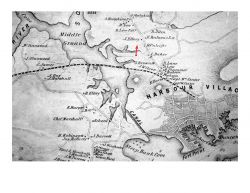
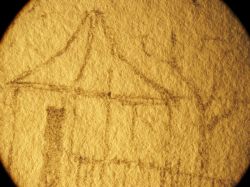
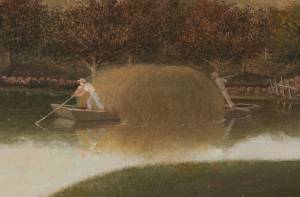
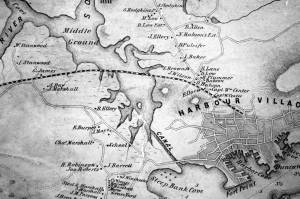


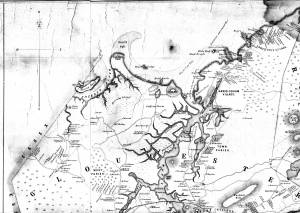

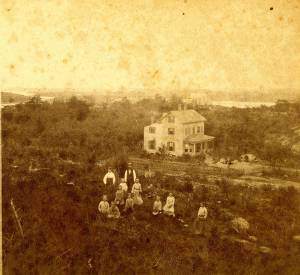

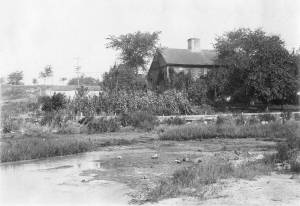
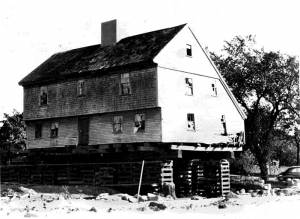
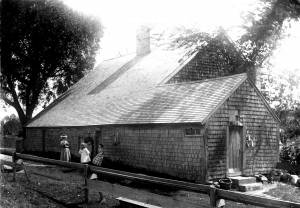

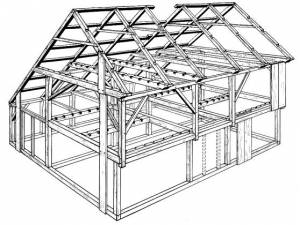


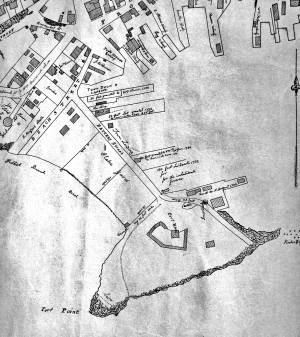

Commentary
This drawing for Babson and Ellery Houses, Gloucester, 1863 (inv. 10) shows the grid and meticulous detail that Lane transferred to the canvas, as can be seen in the infrared images of the painting. Washington Street is the street next to the fence in front of the Babson House and a small building, perhaps an outhouse in the yard. The town landing is to the left of the composition, with the road there leading to the town gravel pit and the two hitching posts that can be seen along the road. Although there is a huge pile of marsh hay in this drawing, absent is the gundalow that is in the painting.
[+] See More